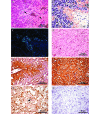Amyloidosis in a Captive Zebra Finch (Taeniopygia guttata) Research Colony
- PMID: 27298248
- PMCID: PMC4907532
Amyloidosis in a Captive Zebra Finch (Taeniopygia guttata) Research Colony
Abstract
Five birds in a captive zebra finch research colony were diagnosed with systemic amyloidosis within a 7-mo period by means of postmortem Congo red staining and green birefringence under polarized light. The liver was the most frequently and usually the most seriously affected organ, followed by the spleen and then the kidney. All 5 birds had been clinically affected with various inflammatory, infectious, and neoplastic conditions associated with amyloid A (AA) amyloidosis in humans and animals. Immunohistochemistry using antisera against duck AA protein revealed that tissues from 2 of the 5 birds were positive for the presence of AA protein and systemic inflammation-associated amyloidosis. Although the development of AA amyloidosis has been associated with chronic inflammation, trauma, and various infectious and neoplastic diseases as well as possible genetic predispositions and stresses linked to overcrowding, the root causes for individual cases of AA amyloidosis are incompletely understood. As far as we know, this report is the first description of AA amyloidosis in captive, research zebra finches.
Figures



References
-
- Animal Welfare Act as Amended. 2008. 7 USC §2131–2156.
-
- Boyce JT, DiBartola SP, Chew DJ, Gasper PW. 1984. Familial renal amyloidosis in Abyssinian cats. Vet Pathol 21:33–38. - PubMed
-
- Buxbaum J. 2006. The genetics of the amyloidoses: interactions with immunity and inflammation. Genes Immun 7:439–449. - PubMed
Publication types
MeSH terms
Substances
LinkOut - more resources
Full Text Sources
Medical
Research Materials
